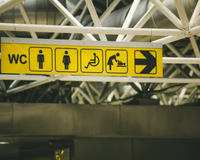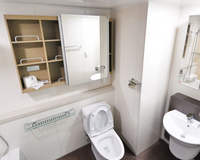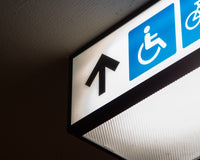Managing a building means keeping track of a lot of things. If you're in building management, you're probably well aware of all of the things that you need to know, understand, and pay attention to at any given moment.
You may be dealing with tenant requests, maintenance issues, or even ADA compliance exemptions. It is essential to stay informed about these exemptions and make sure that you know what to do in any given situation. It’s easy to stay ADA compliant when you hire Choice Builder Solutions to handle your next renovation project. We’re a veteran-owned company that aims to ensure restrooms are accessible to everyone who needs one.
Let's take a look at these exemptions and what the ADA is in-depth below.
What is the ADA?
The Americans with Disabilities Act or ADA was signed into law in 1990. It prohibits discrimination against people with disabilities. It sets forth regulations for businesses to follow to ensure people with disabilities get the same opportunities, access, and rights as any other American.
The ADA was modeled after the Civil Rights Act of 1964. The Civil Rights Act prohibits discrimination based on race, color, religion, sex, or national origin. To be protected by the ADA, you must have a physical or mental impairment that substantially limits one or more major life activities.
What is Title I of the ADA?
The Americans with Disabilities Act is broken into sections called Titles. Title I deals with employment and instructs employers on preventing discrimination in employment matters.
The topics include:
- Job application procedures
- Hiring
- Termination
- Advancement
- Compensation
- Job training
Besides these, it includes other terms, conditions, and privileges relating to employment.
What is Title III of the ADA?
Title III of the ADA prohibits discrimination against the disabled, where activities occur in public places. Some of the categories of businesses under the protections under this title include:
- restaurants
- movie theaters
- schools
- daycare facilities
- recreation facilities
- doctors' offices
- office buildings
- apartment buildings
There are twelve categories in all. This title requires newly built or altered public business spaces as well as some commercial facilities (like warehouses, office buildings, or factories) to comply with these regulations.
Who is Disabled Under the ADA?
The ADA's definition of the term disabled differs from other governmental agencies like the Social Security Administration. It some ways, it is a legal definition more than anything else.
According to the ADA website, to be considered as disabled, a person must have a physical or mental impairment that limits one or more significant life activities substantially. The person should have a history or record of this impairment or be perceived by others as being impaired. Yet, the ADA doesn't list the types of impairments specifically.
ADA Lawsuits: Why They Happen
While the Americans with Disabilities Act began with the best of intentions to protect those with disabilities. Every year a few disabled individuals or organizations use the ADA to file numerous lawsuits to get quick settlements. They have ADA lawsuits down to a science for these types of cases.
A usual case goes something like this: A family with a disabled person in a wheelchair comes to a restaurant. At a point, the disabled person will ask to use the restroom. After returning to the table, he requests to speak to the manager.
Then a complaint is made about the restroom. A lawsuit is filed a few months later that alleges violations of the ADA and the state's laws.
The method used strengthens the case, they were at the restaurant, and restrooms are a prime area where businesses fail ADA regulations. The complaint to the manager is used to prove their grievance was ignored. The family is present to support the statements.
Related: How to Make a Restroom ADA Compliant
ADA Compliance Exemptions
While the ADA lays down a lot of areas that need to be compliant, there are also a few exemptions.
These exemptions are found mainly in sections that relate to employee work areas in particular. A few of these are provided here, but in section 203, there are many more.
203 General Exceptions
In section 4.1.1 (1991), there is an exception that exempts non-occupied or used spaces that have limited ways to be entered. For example, ladders or very narrow passageways and areas that are in use by service personnel only to perform for repairs, maintenance, or occasional equipment monitoring.
Consequently, the 2010 regulations sections 203.4 and 203.5 expanded on the exception by removing the stipulation that the exempt spaces should be not occupied.
203, 206 and 215 Employee Work Areas
In the 1991 regulations, it stated that office staff workspaces in newly constructed or altered areas were required to be created and built so disabled people could advance into, access, and exit the areas as detailed in section 203.9.
They were modified in 2010 and expanded to give some exclusions.
The ADA, 42 USC. 12112 (b)(5)(A) and (B)), that general use passageways within employee work areas must be made accessible and employers must make reasonable conveniences in the business office for people with disabilities, including changes to workspaces where needed.
Tenants - Only Landlords are Responsible
Under Title III of the ADA, a landlord, since an apartment building is a public accommodation space, needs to be ADA compliant. You can delegate the responsibility to the tenant.
Still, under the ADA, the landlord will be liable for any shortcomings in making the building and spaces in it accessible to people with disabilities.
Historic Buildings
Back when many of these buildings were constructed, the Americans with Disabilities Act didn't exist, and, of course, these buildings were not built with people with disabilities in mind. Still, that does not make them exempt today.
The National Preservation Society has prepared a brief to guide historical societies. This brief explains how to implement modifications to historic buildings to make them ADA compliant.
Settling an ADA Lawsuit
Being sued by anyone for ADA compliance issues is a nightmare. It's simple to resolve a claim by settling it, but depending on the circumstances, there can be alternatives. Before deciding to settle out of court, do some research.
The targets of many ADA lawsuits are small businesses. A settlement is a quick method of making it go away, but these types of lawsuits are becoming viral. The first step is making the changes needed to counter the claims and requesting an inspection of the changes.
Large Businesses Face Stricter Guidelines
Compliance with the ADA is mandated for businesses with 15 or more employees, and this is why larger companies face stricter guidelines than others. The larger your company is, the more ADA regulations you have to review to ensure you're complying with all the rules, and regular reviews are needed.
Why Compliance Matters Anyway
Compliance matters because it protects your business from lawsuits, but more than that, it can help you. You're probably shaking your head reading this. Meanwhile, the calculations are forming in your head for all the things that will need to be changed.
Did you know that the upgrades that make your business more accessible can give you advantages over competitors? Besides, expenses and improvements related to ADA compliance can get you a tax credit.
What's Next
Now it's time to begin reviewing the ADA Standards as they apply to your business.
Don't forget to check your written policies and your website. The ADA compliance exemptions may impact you in some way, so it is essential to know and understand them moving forward.
Once you know what you need to do, Choice Builder Solutions can help, so get in touch with us for assistance! We offer customer relations, contractor installations, engineering services and anything else you might need to make sure your establishment is ADA compliant.






2 comments
kathy neal
what extent can ADA due for mobile home parks, and there community pools? we have safety issues, and its part of our contract that we pay for in our rent.
Henry Killingsworth
Thank you for helping me to understand that the ADA prohibits discrimination against people with disabilities. I would imagine that sometimes there are incidents where people with disabilities are discriminated against in workplaces. In this kind of situation, it would be important for the affected people to find a lawyer that can help with ADA situations. https://solnicklaw.com/commercial-business-litigation/